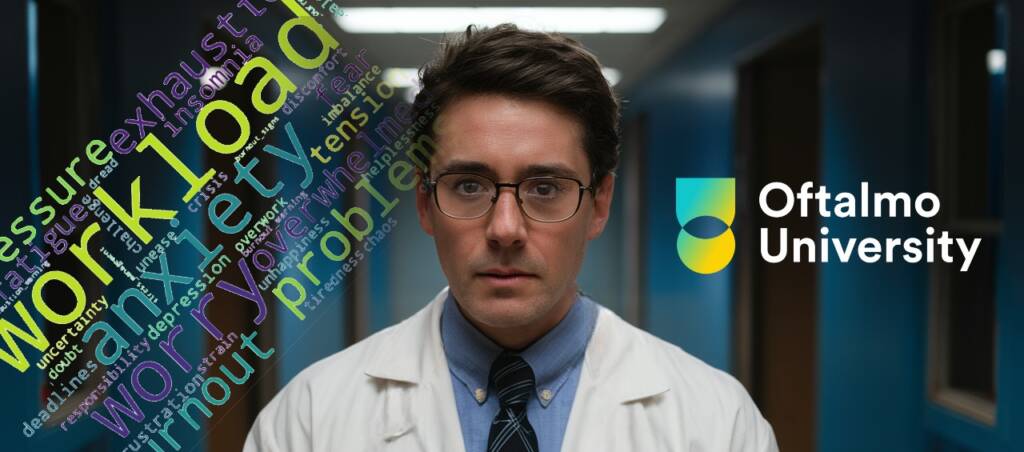*These are the results of a survey conducted from August 23 to 25.
With more than 200 colleagues from 44 countries.

Overall Conclusion of the Survey:
The survey results provide valuable insights into the challenges, concerns, and priorities of ophthalmologists in their practices. The findings highlight several key themes:
- Financial and Operational Pressures: A significant number of ophthalmologists are grappling with increasing operating costs and the financial burdens associated with investing in new technologies. These financial concerns are closely linked to the operational challenges they face, such as implementing new technologies and managing rising costs.
- Focus on Patient Care Quality: Despite these financial and operational challenges, the top priority for ophthalmologists remains the quality of patient care and satisfaction. This reflects a strong commitment to maintaining high standards of care, even as they navigate various other pressures.
- Technology as a Double-Edged Sword: While there is a strong interest in adopting advanced medical equipment and management technologies, there is also significant concern about the costs and accessibility of these technologies. Additionally, while many respondents express interest in AI solutions and virtual assistants to streamline patient interactions, there is a notable portion who remain skeptical or uninterested in these innovations.
- Workload and Staffing Concerns: The survey also reveals concerns about excessive workloads and the challenges of managing skilled personnel. These issues, coupled with the pressures of maintaining relationships with insurers, add to the complexity of running a successful ophthalmology practice.
- Investment Priorities: Looking ahead, ophthalmologists are prioritizing investments in advanced medical equipment and patient acquisition strategies. This indicates a forward-looking approach, aiming to enhance both the technological capabilities and the business aspects of their practices.
In summary, the survey portrays ophthalmologists as professionals who are deeply committed to patient care but are also navigating significant financial, technological, and operational challenges. Their priorities for future investments reflect a balanced approach to maintaining high standards of care while also ensuring the sustainability and growth of their practices.
Below are the complete results:
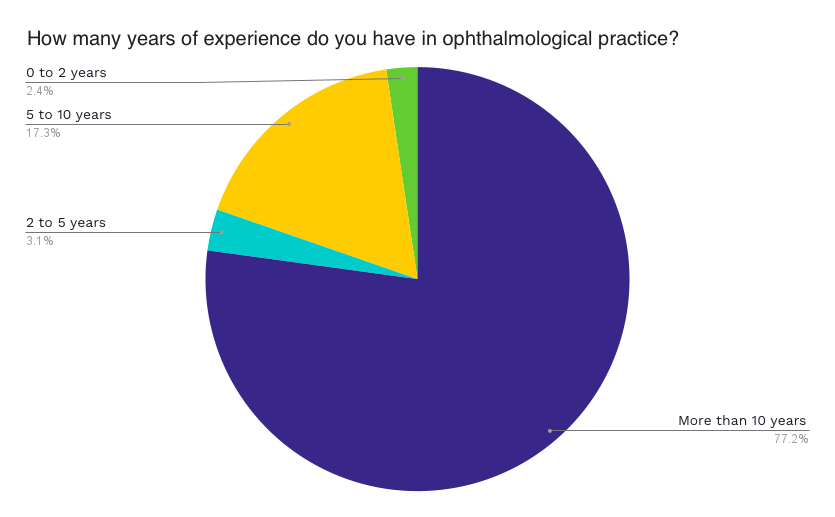
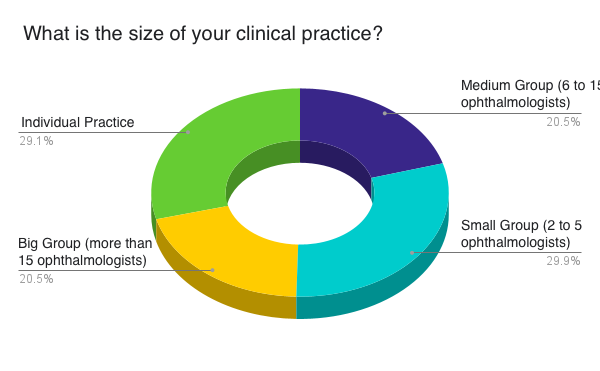
Main operational challenges ophthalmologists face in their practice
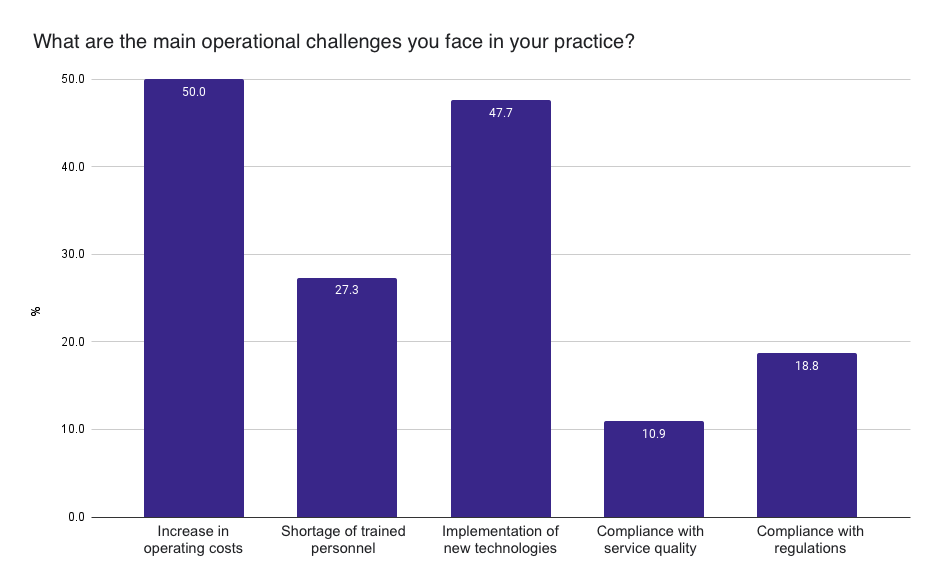
- Increase in Operating Costs: The most significant challenge, cited by 50% of the respondents, is the increase in operating costs. This suggests that managing expenses is a major concern for a majority of ophthalmologists, likely impacting the profitability and sustainability of their practices.
- Implementation of New Technologies: Closely following is the challenge of implementing new technologies, reported by 47.7% of respondents. This highlights the pressure on ophthalmologists to stay updated with the latest advancements, which may require substantial investment and training.
- Shortage of Skilled Personnel: 27.3% of respondents identified the shortage of skilled personnel as a primary challenge. This indicates difficulties in recruiting and retaining qualified staff, which could affect the quality and efficiency of care provided.
The data reflects that financial pressures and technological advancements are the most pressing concerns for ophthalmologists, with regulatory compliance and workforce issues also posing significant challenges.
Interest in having a Virtual Secretary
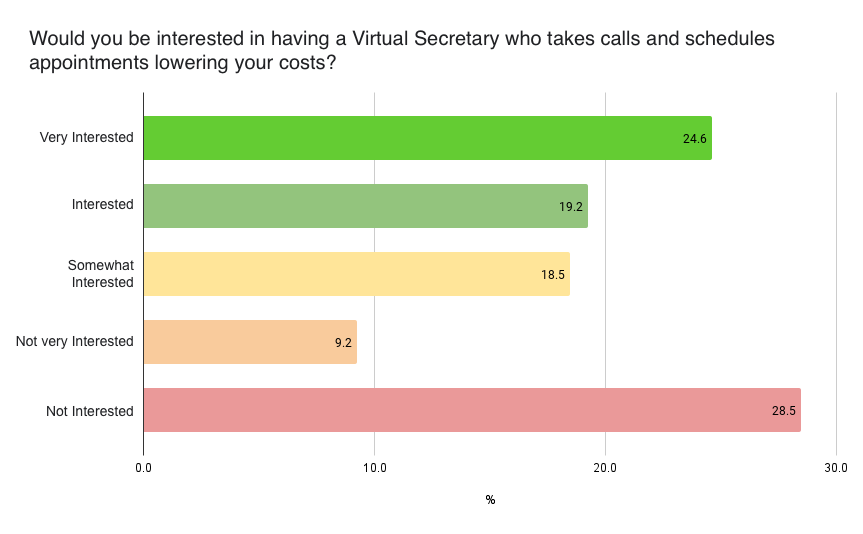
- Diverse Levels of Interest: The respondents show varied levels of interest in a virtual secretary service. While 24.6% are very interested, a similar percentage (28.5%) are not interested at all. This indicates a divided opinion on the value of such a service among ophthalmologists. Are you interested? We can help you
- Moderate Interest: A significant portion of respondents falls into the moderately interested categories: 19.2% are quite interested, and 18.5% are somewhat interested. This suggests that while the concept is appealing to some, it may not be seen as essential.
- Low Interest: Only 9.2% of respondents indicated that they are slightly interested in a virtual secretary, suggesting that a small group sees minimal benefit or relevance in this service.
Interest in having an Artificial Intelligence Agent that answers your patients’ most common concerns
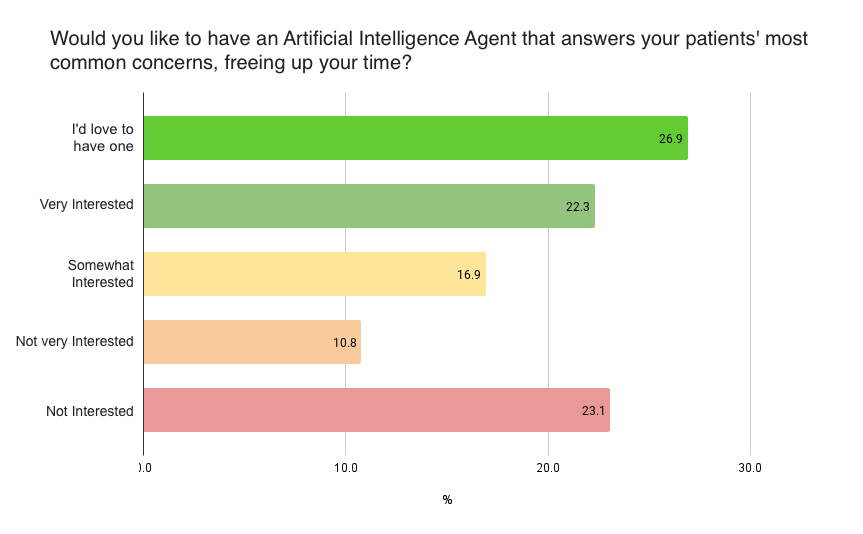
- High Interest: A significant portion of respondents, 26.9%, would love to have an AI agent, and 22.3% are very interested. This indicates a strong interest in leveraging AI technology to enhance patient interaction and potentially reduce the workload. Are you interested? We can help you!
- Moderate Interest: 16.9% of respondents are somewhat interested in this technology. This group sees some potential in AI but may have reservations or require more information on its benefits.
- Low Interest: 10.8% of respondents are slightly interested, which suggests that a smaller group sees limited application for AI in their practice, possibly due to concerns about effectiveness, cost, or patient acceptance.
- No Interest: 23.1% of respondents are not interested at all, highlighting that nearly a quarter of ophthalmologists may be skeptical about or uninterested in AI solutions for patient interaction. This could be due to concerns over losing personal interaction with patients or doubts about the technology’s ability to meet patient needs.
Overall, the data reflects a generally positive attitude toward the integration of AI in patient care among ophthalmologists, with a notable proportion expressing enthusiasm. However, there is also a significant group that is either indifferent or opposed, indicating the need for further education or demonstration of the benefits of AI in medical practices.
Main concern regarding patient care
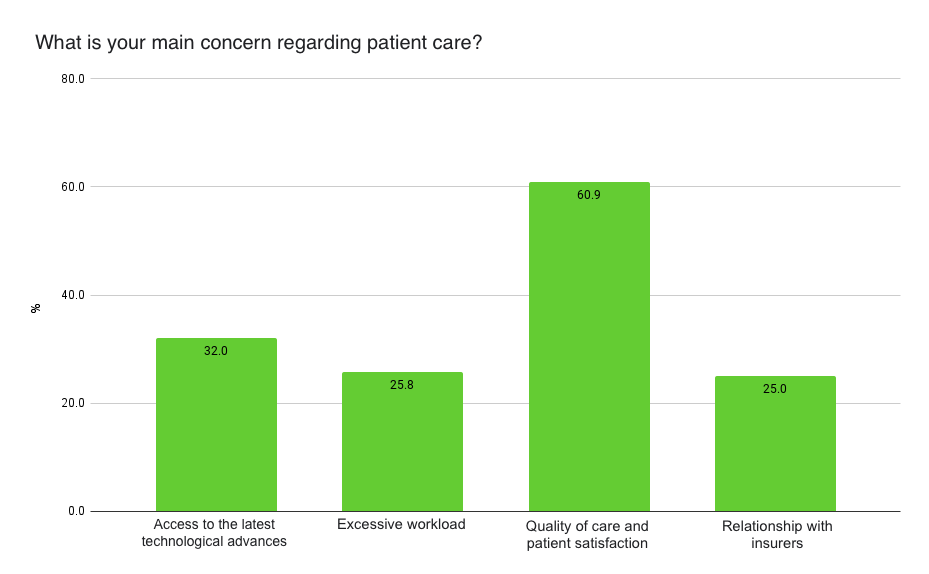
- Quality of Care and Patient Satisfaction: The most significant concern, indicated by 60.9% of respondents, is the quality of care and patient satisfaction. This highlights that providing high-quality care and ensuring patient satisfaction are paramount priorities for ophthalmologists.
- Access to the Latest Technological Advances: 32% of respondents are concerned about access to the latest technological advancements. This suggests that keeping up with modern medical technologies is crucial for providing effective patient care, but it also presents challenges in terms of accessibility and cost.
- Excessive Workload: 25.8% of respondents expressed concern about excessive workload. This indicates that heavy workloads could be impacting the ability of ophthalmologists to maintain the desired level of patient care and attention.
- Relationship with Insurers: 25% of the respondents are worried about their relationships with insurers. This concern may stem from the complexity of dealing with insurance companies, which could affect both the financial aspects of their practice and the patient care process.
While the quality of patient care is the top concern, other factors such as technology access, workload management, and insurer relationships also play significant roles in shaping the patient care experience for ophthalmologists.
Biggest financial concerns
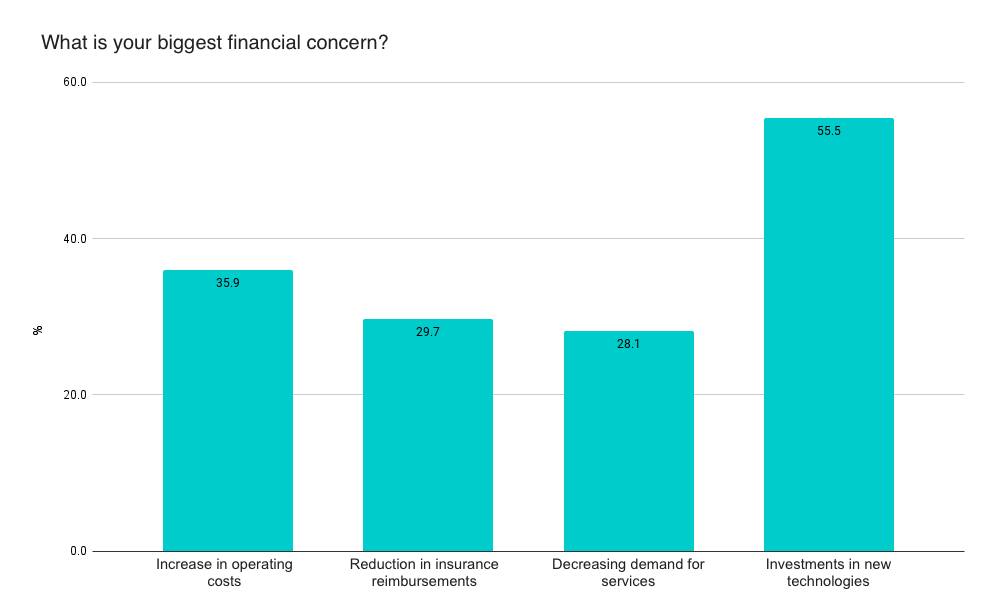
- Investments in New Technologies: The most significant financial concern, reported by 55.5% of respondents, is the investment in new technologies. This indicates that while staying current with technological advancements is crucial, it also represents a considerable financial burden for many practitioners.
- Increase in Operating Costs: 35.9% of respondents are worried about the rising operating costs. This aligns with the challenges seen in operational concerns, reflecting that managing costs is a recurring theme of concern for ophthalmologists.
- Reduction in Insurance Reimbursements: 29.7% of the respondents identified the reduction in insurance reimbursements as a major financial concern. This suggests that changes in reimbursement policies from insurers are putting additional financial pressure on practices.
- Decline in Service Demand: 28.1% of respondents are concerned about a decrease in the demand for services. This could reflect broader market trends or patient behavior changes that could impact revenue.
The data shows that the most pressing financial concern for ophthalmologists is the cost of investing in new technologies, followed by the management of rising operational costs and the potential impacts of reduced reimbursements and service demand on their financial stability.
Top Investment Priorities
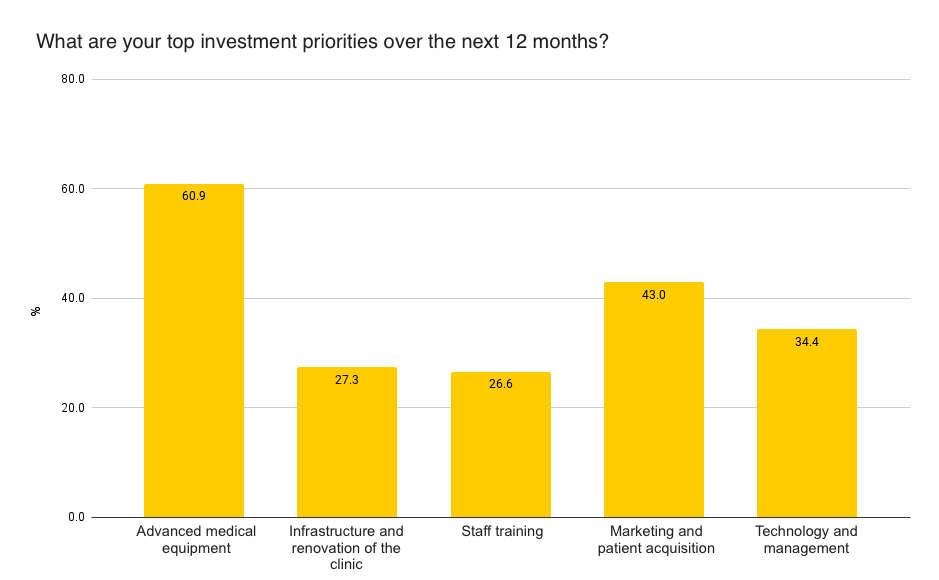
- Advanced Medical Equipment: The highest priority for investment, selected by 60.9% of respondents, is advanced medical equipment. This reflects a strong focus on acquiring or upgrading medical technologies to enhance diagnostic and treatment capabilities.
- Marketing and Patient Acquisition: 43% of respondents prioritize investment in marketing and patient acquisition. This suggests that expanding patient bases and enhancing practice visibility are critical goals for many ophthalmologists.
- Management Technology and Software: 34.4% of respondents plan to invest in management technology and software. This indicates a recognition of the importance of efficient practice management systems to streamline operations and improve overall practice efficiency.
- Clinic Infrastructure and Renovation: 27.3% of respondents see infrastructure and clinic renovation as a priority. This suggests that maintaining or improving physical facilities is also important, though not as urgent as other investment areas.
- Staff Training: 26.6% of respondents identified staff training as a priority. This underscores the need for continuous education and skills enhancement to ensure that staff can effectively use new technologies and maintain high standards of patient care.
Overall, the data reveals a strong emphasis on technology—both in terms of medical equipment and management systems—alongside efforts to boost patient acquisition and maintain or upgrade physical and human resources within the practice.

